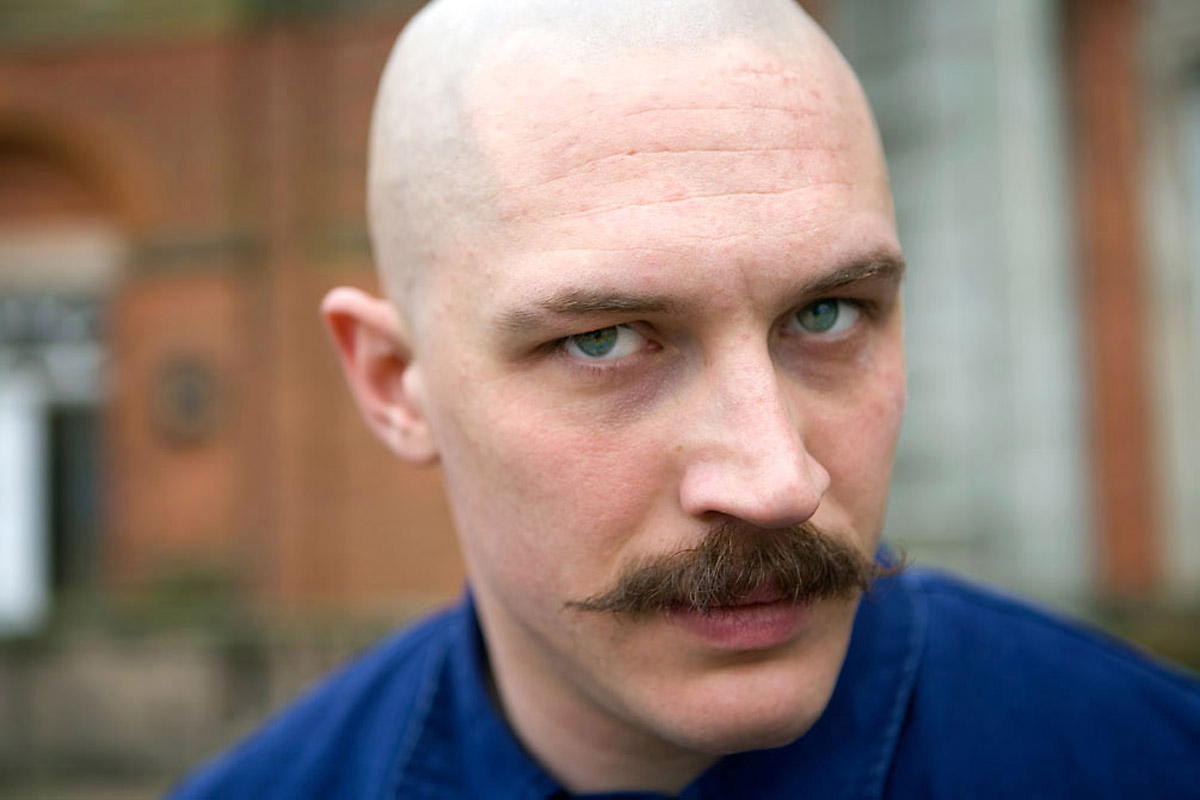
After exploding onto the European film scene in the mid-1990s, Nicolas Winding Refn made a name for himself early on by using his colorful knack for attitude and style to direct gritty crime dramas, including Pusher (1996) and Bleeder (1999).
The Danish filmmaker has since gone on to create some of the most vividly violent thrillers of modern cinema and has solidified his reputation for unquestioning individuality and undeniable controversy. Met with as much aversion as acclaim, Refn’s work continues to push the boundaries of narrative structure and characterization, and strives to dismantle the typical conventions of Hollywood in favor of a more abstract approach.
Each of Refn’s films presents the audience with a vibrant display of visual storytelling and demonstrates the director’s deep sense of wonder at what transforms us into the individuals we inevitably become. Out of his brief-but-bold filmography, 10 scenes have been chosen that exemplify Refn’s use of audacious imagery to illustrate the characters and narratives which inhabit his cinematic landscape.
Ranging from the crimson hallucinations of a man haunted by his past, to the ritual sacrifice of a fashion model to extract her beauty, these scenes encompass the darkest fears and obsessions on which many (Refn especially) find themselves inexorably fixated.
1. Pusher Trilogy (1996-2005), Tonny Finds “Respect”
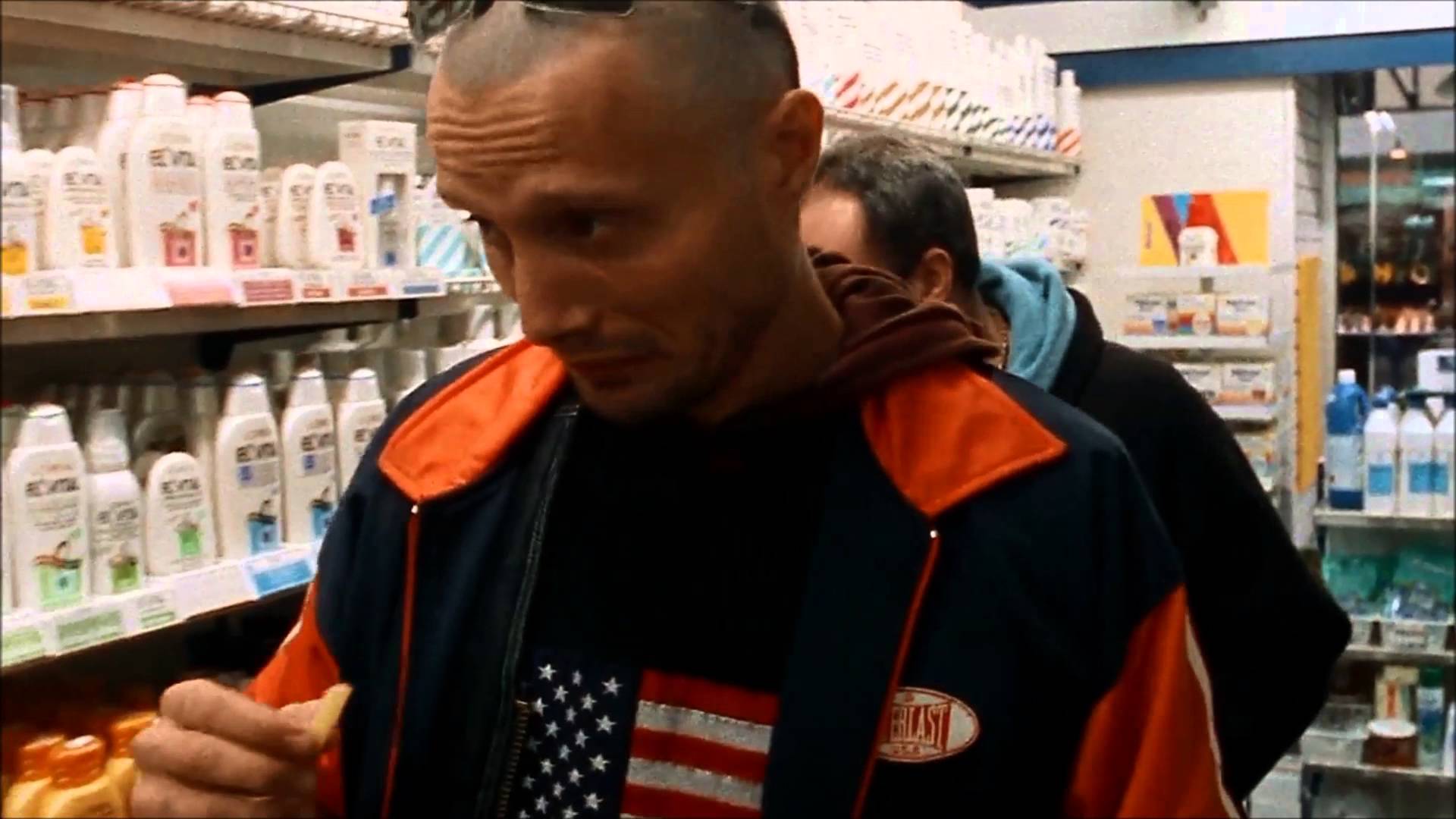
Scene: In Refn’s Pusher trilogy, each film examines the personal and professional lives of several sordid drug “pushers” as they go about their daily routines, chronicling everything from meeting friends for coffee to setting up the daring robbery of rival dealers. The series firmly established Refn’s career as an energetic young filmmaker whose eye for striking visuals and kinetic storytelling helped to elevate the crime genre to new and inspired heights.
Pusher II (2004) is the obvious standout here and features an impressive leading role for Mads Mikkelsen who plays Tonny, the son of a notorious gangster and an ex-convict fresh out of prison who must grapple with the responsibility of becoming a father himself.
Tonny spends a majority of the film attempting to navigate life outside prison walls, but struggles to find any kind of work or relationships that don’t have to do with the drug trade. After exhausting his efforts to break from his father’s shadow, Tonny ultimately succumbs to his violent urges and brutally stabs his father to death. He then flees the city via bus, taking his young child with him, and sets out to find a new life in which they can both find refuge from their past. The final scene shows father and son watching out the window as painful memories slide by; the camera lingering on a shot of Tonny’s scalp tattoo which reads “Respect”.
Significance: As is the case for much of Refn’s work, Pusher II evokes a powerful aura of luridness and arouses our fascination with the darker side of existence. Tonny’s journey through this world of killers and drug pushers is fueled by an inescapable drive towards self-fulfillment, as well as a capacity for tendencies of self-destruction. He labors tirelessly against those forces which fight to keep him restrained, including familial relationships and societal institutions such as prison, and in doing so creates the necessary opportunities for him and his son to live freely.
By framing this last shot to focus on Tonny’s tattoo, Refn visually punctuates the overarching motivation for each character in the film and hints at the possible inspiration for many of the viewers’ own strive for success: Respect.
The imagery here is far from sanctimonious, but conversely seems to prompt a moral question about self-determination and its role in the justification of criminally violent behavior. Tonny hopes that killing his father and giving his son the chance to grow up away from this life of crime will finally bring him the self-respect he so desires, but he must first understand that his past is something to both accept and learn from rather than something to be forgotten.
2. Fear X (2003), The Red Hallway
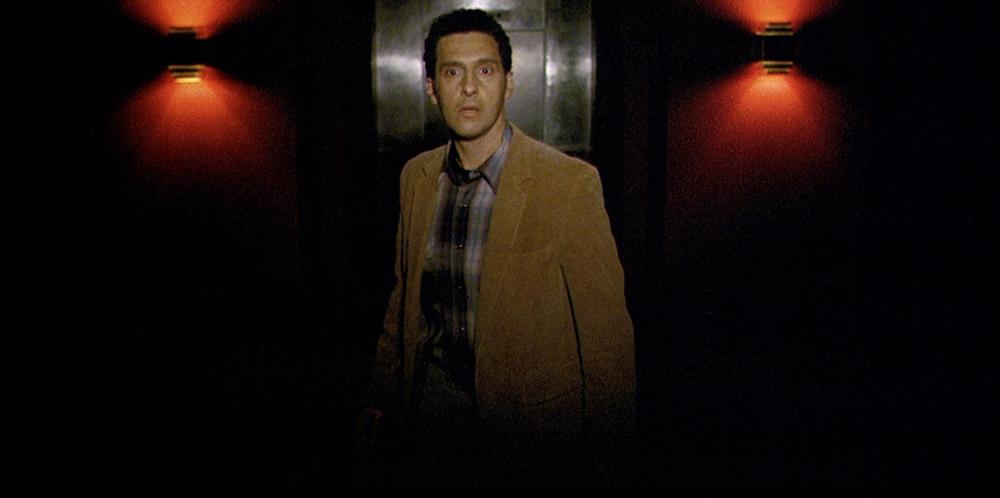
Scene: Before making his successful return to the Pusher series, Refn tried his hand at directing a U.S. production with the little-known and oft-dismissed Fear X, which follows a security guard named Harry (played by John Turturro) who obsesses over the mysterious circumstances of his wife’s death.
As the film grapples with questions of authority and the nature of memory, Refn uses his signature flair for the abstract to show the painful transformation of Harry’s obsession with the past. In one particular scene, the film dives headfirst into the true psyche of fear and employs a near Lynch-ian view of how this fear may only end in unfathomable rage and self-destruction.
Near the climax of the film, Harry manages to find and confront the man whom he believes killed his wife. Unbeknownst to Harry, the man (played by James Remar) is actually a cop and never intended to kill anyone, but now rationalizes his actions to ensure the safety of his own family. A struggle erupts and Harry is shot before he is able to pursue the man. Wounded and alone on an elevator, Harry is left to watch as hallucinations of dark red images flood his mind.
The audience is met with a vivid collage of crimson colored textures and shapes, repeatedly taking form before melting back into a hazy liquid. Then the doors open and Harry looks out at a sea of red as it pools across the hallway and traps him in its embrace.
Significance: With Fear X, Refn appears to be focused on pain as a transcendent state and shows how the minutia of our daily lives can oscillate this pain in and out of our minds. The pain Harry feels may never be gone entirely, but his relentless obsession over the death of his wife undoubtedly controls his every waking moment and makes it truly impossible for Harry to let go. Refn is able to utilize Harry’s pain as a manifestation of this idea throughout the film and emphasizes its nature of transcendence by visually portraying it in the form of monochromatic imagery.
Harry’s hallucinations seem to be brought on after seeing the blood from his gunshot wound, but these visions also symbolize the dramatic breaking point for his all-but-fractured psyche. The red tinted images which fill the screen suggest that, much like his own blood, Harry’s pain has begun to seep from his body to reveal the agonizing truth hiding beneath. He must accept the fact that his wife’s death was a tragic mistake and that his tireless investigation has led him down a path replete with unanswered questions and unending pain.
3. Bronson (2008), Hospital Dance Party
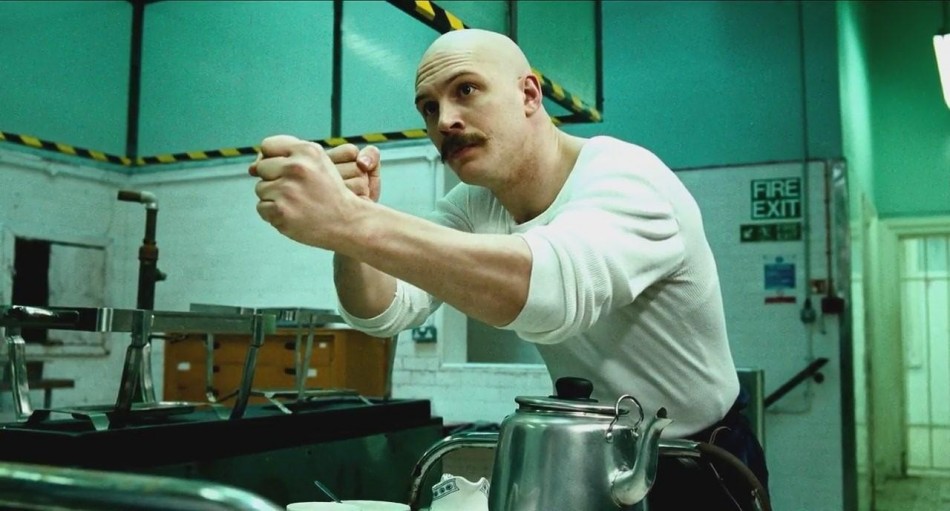
Scene: Refn’s predilection for violence has always served as a source of inspiration for his narratives and helps to construct the personal motivations for many of the characters in his films. None are as outright obvious about this inspiration as Bronson, which sees Tom Hardy starring as the titular convict who finds himself in and out of incarceration for most of his life and who, for lack of a better purpose, actually enjoys fighting his way back into prison. The film is understandably violent, even gratuitous at times, yet still maintains an acute awareness for depicting this violence within a thematic context.
One of the more surreal scenes of the film comes when Bronson (originally named Michael Peterson) finds himself in the custody of a psychiatric hospital after he is deemed “too violent” to remain in the prison’s general population.
Heavily medicated and seemingly docile, Bronson attends a dance party with some of the other patients, but uses the occasion to spot weaknesses in the hospital’s security. He shuffles through a disorienting crowd of people and heads for a nearby exit, but two guards stop him and motion for his return to the party. As bright lights flash and Pet Shop Boys plays overhead, Bronson has an emotional realization that his stay at the hospital will be far less combative than in prison and that it might ultimately break his spirit to fight back.
Significance: For the first time in the film, Bronson is unable to use his characteristically violent outbursts against those figures of authority he despises so much, and must succumb to their demands despite his best efforts. And unlike the degrading experiences he receives in prison, Bronson’s hostility in the psychiatric hospital is met with medication rather than punishment, and stress-reduction strategies instead of confinement.
In many ways, this particular scene epitomizes Bronson’s constant struggle for self-actualization and reflects his need to revolt against traditional forms of modern society as a way of coping with the belief that he does not belong.
Refn expertly captures Bronson’s disassociation with the modern world by underlining the scene with hypnotic dance music and colorful strobing lights, all of which create an uncanny surrealism that gives this world a nightmarish mania.
By blocking the action within the confines of an elaborate ballroom, rotting wallpaper included, Bronson appears to literally be wandering through some version of Hell where in his punishment is to surrender any prospect of free will. Bronson is eventually released from the hospital and his reign of violence assuredly continues, but the infamy he soon accrues from the public makes it evident that his actions may actually be emblematic of a societal fascination with violence.
4. Bronson (2008), Art Studio Standoff
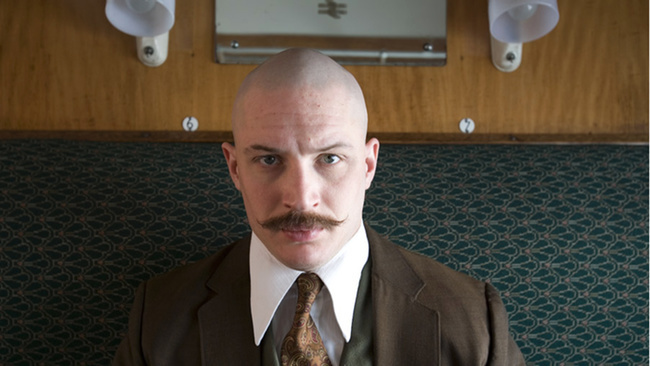
Scene: After a comically brief period of freedom, Bronson is inevitably sent back to prison where he abruptly takes a librarian hostage and gets into a vicious brawl with the guards. With this, the prison warden cautions Bronson that, if his violent behavior does not come to an end, he will more than likely die in solitary confinement.
Much to the surprise of everyone, Bronson seems to heed this warning and begins to explore his artistic side through drawing. He is encouraged by an art teacher to channel his rage into illustrations of various creatures, some real and some not, and is allowed special access to the prison’s art studio.
When he learns that the art program is going to end, Bronson takes the teacher hostage and locks the both of them inside the studio where a standoff with the guards then ensues.
From behind locked doors, Bronson is seen covering his entire body in black paint and demands that the guards play music for them overhead. He ties the teacher to a support beam, paints a mustache onto the man’s face, and then clothes him with his own hat and pair of glasses. Once this human piece of art is complete, Bronson grows weary and taunts the prison guards to come and try to subdue him. In one last brawl, Bronson is finally defeated and sent back to solitary for good.
Significance: The mythos of Bronson is certainly an exaggerated one, steeped in heavy embellishments and questionable evidence, but is nonetheless provocative and caters to an audience’s fascination with both contentious personalities as well as violence in general.
The violence to which Bronson is so accustomed and for which he is so renowned could also be pointed to as the primary reason for his ultimate demise, but it may truly be his categorical hatred for unchallenged societal hypocrisies which lead to his downfall. Rather than succumbing to the commonly held response of apathy toward these hypocrisies, Bronson chooses to physically battle against the established institutions he sees as the chief perpetrators.
With his own, creatively driven methods, Refn appears to be equally impatient when it comes to these hypocritical institutions and effectively uses his artistic ability to reflect this desire for societal accountability. Similar to Bronson’s carnal search for meaning in his world, Refn’s work allows him to express the problems that he sees facing our world today; and just like Bronson’s disillusionment after the prison art program ends, Refn is clearly frustrated with how certain establishments, including prisons, choose to address these fundamental issues.
If the ambiguous, albeit decidedly pessimistic ending of the film reveals anything, it is that the world is not simply shaped by our hopes and desires, nor is it dictated by what is right or fair, but instead reflects the care and attention we as a society chose to bring forth and only through our actions toward change can our demands for it be achieved.
5. Valhalla Rising (2009), The Fate of One-Eye
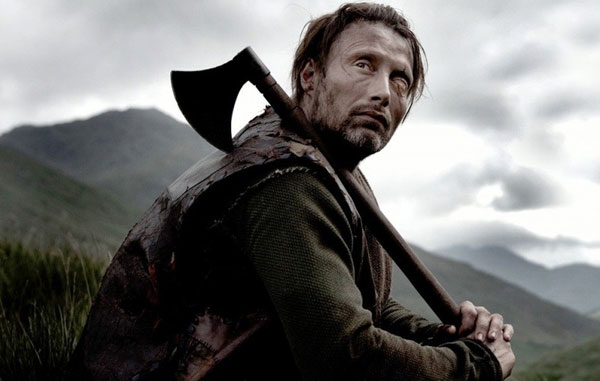
Scene: Refn’s immediate follow-up to Bronson is as violent and bleak as any of his previous efforts, but also representative of the director’s segue from conventional narrative structures into more experiential filmmaking.
Valhalla Rising tells the story of a Viking warrior named One-Eye who, after freeing himself from the captivity of a warring tribe, travels with a young boy and Norse Christian crusaders to discover the New World. Their journey is fraught with hunger and desolation, and will ultimately lead to misery and death for them all, but One-Eye envisions what the New World holds for him and willingly accepts this fate.
After losing most of the crusaders, One-Eye and the boy finally arrive at the coast, but soon realize that they are surrounded by a group of native warriors who show no signs of mercy. One-Eye stares back at them with the acceptance of what is to come next, and motions for the boy to stay behind.
After dropping his knife and axe before the men, and ceremonially submitting himself over to them, one of the warriors approaches and completes One-Eye’s vision by clubbing him in the back of the head. An image of One-Eye’s soul walks into the open water next to a stone monument and vanishes beneath the surface, leaving the boy alone to stare out at the ocean.
Significance: The symbology behind One-Eye’s death and his subsequent passage into the metaphysical realm underscores many of the themes present in the film, including spiritual retribution and the chaos of discovery. One-Eye was once a captive himself, so the notion of a “New World” undoubtedly offers the chance at new beginnings, but at what cost are these beginnings obtainable and at what risks will he take to ensure his freedom?
Ultimately, the savagery of the old world is inextricably present in the New, and One-Eye comes to accept the same fate as other warriors like him who have lived and died by the violence which has so defined their existence.
Refn’s stark imagery in the film captures One-Eye’s hellish descent into the unknown and helps to reflect the harsh conditions in which the warrior and Christian crusaders find themselves. In building the story from an experiential structure rather than a conventional narrative, Refn frees himself to navigate even the smallest of details in this mysterious world without the restrictions commonly associated with traditional plotting.
The way in which the camera is allowed to linger with the characters and catch their every emotion seems to transcend plot, but also sets up an exciting new precedent for Refn’s future projects in which the director attempts to create stories that are more focused on the overall atmosphere than anything else.